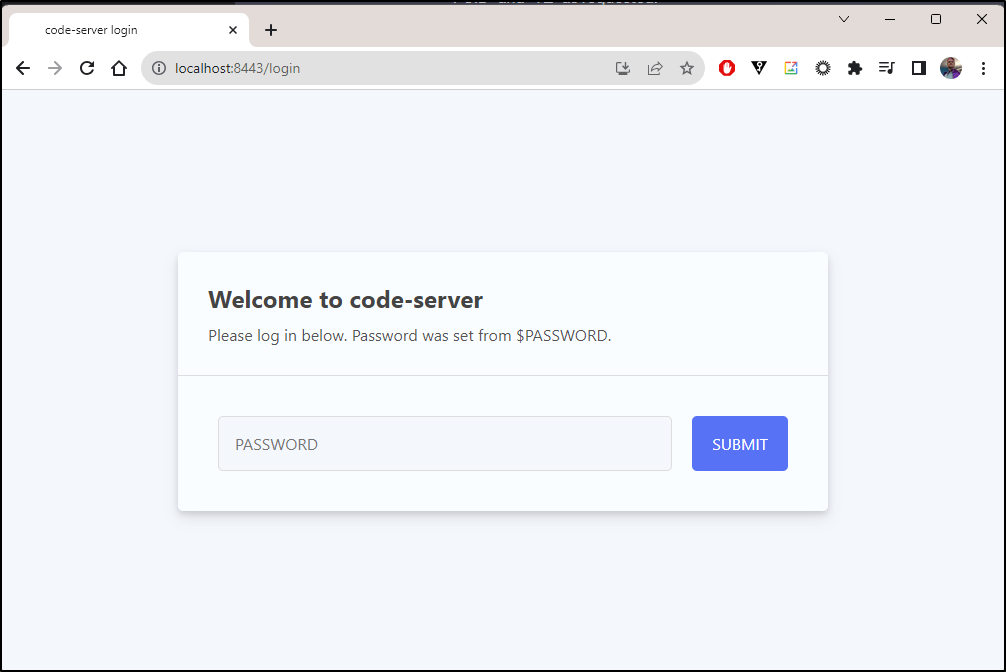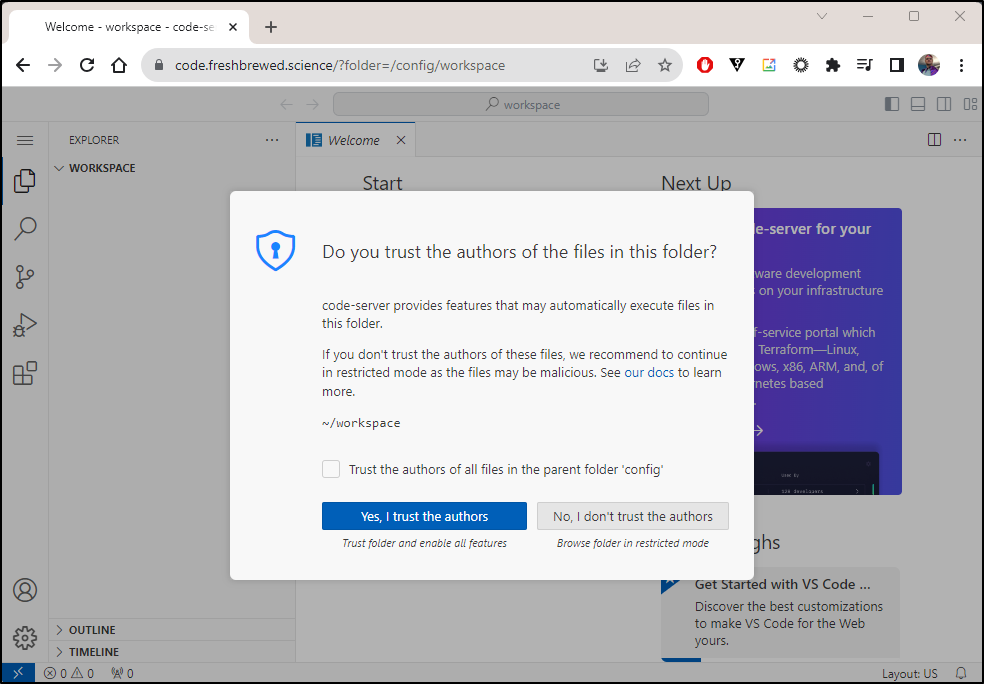Published: Nov 16, 2023 by Isaac Johnson
I saw a blog article a while back showing how to install Code Server on a NAS for remote development. I thought it might be fun to try and do similar and expose through Kubernetes.
Installation
If we look at the Docker image from linuxserver.io’s library, we can see a rather straight-forward Docker compose file:
---
version: "2.1"
services:
code-server:
image: lscr.io/linuxserver/code-server:latest
container_name: code-server
environment:
- PUID=1000
- PGID=1000
- TZ=Etc/UTC
- PASSWORD=password #optional
- HASHED_PASSWORD= #optional
- SUDO_PASSWORD=password #optional
- SUDO_PASSWORD_HASH= #optional
- PROXY_DOMAIN=code-server.my.domain #optional
- DEFAULT_WORKSPACE=/config/workspace #optional
volumes:
- /path/to/appdata/config:/config
ports:
- 8443:8443
restart: unless-stopped
We can turn that into a pretty straightforward Deployment YAML
apiVersion: apps/v1
kind: Deployment
metadata:
name: code-server-deployment
spec:
replicas: 1
selector:
matchLabels:
app: code-server
template:
metadata:
labels:
app: code-server
spec:
containers:
- name: code-server-container
image: lscr.io/linuxserver/code-server:latest
ports:
- containerPort: 8443
env:
- name: PUID
value: "1000"
- name: PGID
value: "1000"
- name: PASSWORD
value: "TestPassword01"
- name: SUDO_PASSWORD
value: "TestPassword02"
- name: TZ
value: "Etc/UTC"
volumeMounts:
- name: code-server-config
mountPath: /config
volumes:
- name: code-server-config
persistentVolumeClaim:
claimName: code-server-pvc
---
apiVersion: v1
kind: PersistentVolumeClaim
metadata:
name: code-server-pvc
spec:
storageClassName: local-path
accessModes:
- ReadWriteOnce
resources:
requests:
storage: 5Gi
I’ll launch it in the Test Kubernetes
$ kubectl apply -f test-codeserver.yaml
deployment.apps/code-server-deployment created
persistentvolumeclaim/code-server-pvc created
I soon see it running
$ kubectl get pods -l app=code-server
NAME READY STATUS RESTARTS AGE
code-server-deployment-66d98759fc-t2vdl 1/1 Running 0 47s
I’ll port-forward
$ kubectl port-forward code-server-deployment-66d98759fc-t2vdl 8443:8443
Forwarding from 127.0.0.1:8443 -> 8443
Forwarding from [::1]:8443 -> 8443
Handling connection for 8443
Handling connection for 8443
I am prompted for the password
Then whether I trust the authors
I picked a theme then went to source control
Let’s try a couple ways to engage with Git
Here I will use the terminal to clone a repo in Gitea, but then the UI to create a commit and push:
My next test is object permanence; let’s kill the pod and ensure things were saved in the PVC
My final test was to ensure the sudo password was actually the one I specified and not just the login one:
I was slightly worried it was just remote sharing (like VNC) so I fired an incognito window and indeed it asked for a password, so it is handling session management.
If I use this in Prod, I might need more space. This blog’s GIT repo is nearly 6Gb already.
$ du -chs ./jekyll-blog
5.8G ./jekyll-blog
5.8G total
I’m kind of stumped on what to do about that, to be honest. I don’t really want to purge old articles but as of this writing, I have 50 pages of blog entries going back to 2019 and the rendered static site is nearly 4Gb.
Moving to production
Let’s next create a quick A record
$ cat r53-codeserver.json
{
"Comment": "CREATE code fb.s A record ",
"Changes": [
{
"Action": "CREATE",
"ResourceRecordSet": {
"Name": "code.freshbrewed.science",
"Type": "A",
"TTL": 300,
"ResourceRecords": [
{
"Value": "75.73.224.240"
}
]
}
}
]
}
$ aws route53 change-resource-record-sets --hosted-zone-id Z39E8QFU0F9PZP --change-batch file://r53-codeserver.json
{
"ChangeInfo": {
"Id": "/change/C0135361308ECV801OVU",
"Status": "PENDING",
"SubmittedAt": "2023-11-03T12:46:41.994Z",
"Comment": "CREATE code fb.s A record "
}
}
I’ll now change the storage class, add a service and lastly the Ingress in one single YAML
$ cat prod-codeserver.yaml
---
apiVersion: apps/v1
kind: Deployment
metadata:
name: code-server-deployment
spec:
replicas: 1
selector:
matchLabels:
app: code-server
template:
metadata:
labels:
app: code-server
spec:
containers:
- name: code-server-container
image: lscr.io/linuxserver/code-server:latest
ports:
- containerPort: 8443
env:
- name: PUID
value: "1000"
- name: PGID
value: "1000"
- name: PASSWORD
value: "MyPasswordHere!"
- name: SUDO_PASSWORD
value: "MyOtherPasswordHere!"
- name: TZ
value: "America/Chicago"
volumeMounts:
- name: code-server-config
mountPath: /config
volumes:
- name: code-server-config
persistentVolumeClaim:
claimName: code-server-pvc
---
apiVersion: v1
kind: PersistentVolumeClaim
metadata:
name: code-server-pvc
spec:
storageClassName: managed-nfs-storage
accessModes:
- ReadWriteOnce
resources:
requests:
storage: 20Gi
---
apiVersion: v1
kind: Service
metadata:
name: codeserver-service
spec:
ports:
- name: http
port: 80
protocol: TCP
targetPort: 8443
selector:
name: code-server
type: ClusterIP
---
apiVersion: networking.k8s.io/v1
kind: Ingress
metadata:
annotations:
cert-manager.io/cluster-issuer: letsencrypt-prod
kubernetes.io/ingress.class: nginx
kubernetes.io/tls-acme: "true"
ingress.kubernetes.io/proxy-body-size: "0"
ingress.kubernetes.io/ssl-redirect: "true"
nginx.ingress.kubernetes.io/proxy-read-timeout: "3600"
nginx.ingress.kubernetes.io/proxy-send-timeout: "3600"
nginx.org/websocket-services: code-service
nginx.ingress.kubernetes.io/proxy-body-size: "0"
nginx.ingress.kubernetes.io/ssl-redirect: "true"
nginx.org/client-max-body-size: "0"
nginx.org/proxy-connect-timeout: "3600"
nginx.org/proxy-read-timeout: "3600"
labels:
app.kubernetes.io/instance: codeingress
name: codeingress
spec:
rules:
- host: code.freshbrewed.science
http:
paths:
- backend:
service:
name: codeserver-service
port:
number: 80
path: /
pathType: ImplementationSpecific
tls:
- hosts:
- code.freshbrewed.science
secretName: code-tls
I’ll create a namespace and launch the whole lot into it
$ kubectl create ns codeserver
namespace/codeserver created
$ kubectl apply -f prod-codeserver.yaml -n codeserver
deployment.apps/code-server-deployment created
persistentvolumeclaim/code-server-pvc created
service/codeserver-service created
ingress.networking.k8s.io/codeingress created
I can see the pod, pvc and server came up pretty quick
$ kubectl get pods -n codeserver
NAME READY STATUS RESTARTS AGE
code-server-deployment-888945468-fl7fz 1/1 Running 0 37s
$ kubectl get svc -n codeserver
NAME TYPE CLUSTER-IP EXTERNAL-IP PORT(S) AGE
codeserver-service ClusterIP 10.43.2.208 <none> 80/TCP 41s
$ kubectl get pvc -n codeserver
NAME STATUS VOLUME CAPACITY ACCESS MODES STORAGECLASS AGE
code-server-pvc Bound pvc-675caa85-7a57-42bd-9f0f-82f785fd1ef4 20Gi RWO managed-nfs-storage 92s
but something isn’t as good with the ingress
$ kubectl get ingress -n codeserver
NAME CLASS HOSTS ADDRESS PORTS AGE
codeingress <none> code.freshbrewed.science 80, 443 46s
$ kubectl get cert -n codeserver
NAME READY SECRET AGE
code-tls False code-tls 68s
$ kubectl get cert -n codeserver
NAME READY SECRET AGE
code-tls True code-tls 11m
I saw a couple issues; the ingress had a bit too many annotations and the service should have used “app” not “name” on the selector:
---
apiVersion: v1
kind: Service
metadata:
name: codeserver-service
spec:
ports:
- name: http
port: 80
protocol: TCP
targetPort: 8443
selector:
app: code-server
type: ClusterIP
---
apiVersion: networking.k8s.io/v1
kind: Ingress
metadata:
annotations:
cert-manager.io/cluster-issuer: letsencrypt-prod
ingress.kubernetes.io/proxy-body-size: "0"
ingress.kubernetes.io/ssl-redirect: "true"
kubernetes.io/ingress.class: nginx
nginx.ingress.kubernetes.io/proxy-body-size: "0"
nginx.ingress.kubernetes.io/proxy-read-timeout: "3600"
nginx.ingress.kubernetes.io/proxy-send-timeout: "3600"
nginx.ingress.kubernetes.io/ssl-redirect: "true"
nginx.org/client-max-body-size: "0"
nginx.org/proxy-connect-timeout: "3600"
nginx.org/proxy-read-timeout: "3600"
labels:
app.kubernetes.io/name: code
name: codeingress
spec:
rules:
- host: code.freshbrewed.science
http:
paths:
- backend:
service:
name: codeserver-service
port:
number: 80
path: /
pathType: ImplementationSpecific
tls:
- hosts:
- code.freshbrewed.science
secretName: code-tls
I’ll reapply
$ kubectl apply -f prod-codeserver.yaml -n codeserver
deployment.apps/code-server-deployment unchanged
persistentvolumeclaim/code-server-pvc unchanged
service/codeserver-service configured
ingress.networking.k8s.io/codeingress configured
That looks much better
I might have issues with Nginx - seems this needs websockets
I’ll wipe the existing Nginx and add “websocket-services” annotation
$ kubectl delete ingress codeingress -n codeserver
ingress.networking.k8s.io "codeingress" deleted
$ cat prod-codeserver.yaml | tail -n40
targetPort: 8443
selector:
app: code-server
type: ClusterIP
---
apiVersion: networking.k8s.io/v1
kind: Ingress
metadata:
annotations:
cert-manager.io/cluster-issuer: letsencrypt-prod
ingress.kubernetes.io/proxy-body-size: "0"
ingress.kubernetes.io/ssl-redirect: "true"
kubernetes.io/ingress.class: nginx
nginx.ingress.kubernetes.io/proxy-body-size: "0"
nginx.ingress.kubernetes.io/proxy-read-timeout: "3600"
nginx.ingress.kubernetes.io/proxy-send-timeout: "3600"
nginx.ingress.kubernetes.io/ssl-redirect: "true"
nginx.org/client-max-body-size: "0"
nginx.org/proxy-connect-timeout: "3600"
nginx.org/proxy-read-timeout: "3600"
nginx.org/websocket-services: codeserver-service
labels:
app.kubernetes.io/name: code
name: codeingress
spec:
rules:
- host: code.freshbrewed.science
http:
paths:
- backend:
service:
name: codeserver-service
port:
number: 80
path: /
pathType: ImplementationSpecific
tls:
- hosts:
- code.freshbrewed.science
secretName: code-tls
Then re-apply
$ kubectl apply -f prod-codeserver.yaml -n codeserver
deployment.apps/code-server-deployment unchanged
persistentvolumeclaim/code-server-pvc unchanged
service/codeserver-service unchanged
ingress.networking.k8s.io/codeingress created
Thankfully that worked:
I noted it doesn’t show just the PVC claim size
Rather, it’s just exposing the host nodes stats:
builder@builder-HP-EliteBook-850-G2:~$ df -h
Filesystem Size Used Avail Use% Mounted on
udev 7.8G 0 7.8G 0% /dev
tmpfs 1.6G 9.0M 1.6G 1% /run
/dev/sda5 234G 83G 139G 38% /
tmpfs 7.8G 0 7.8G 0% /dev/shm
tmpfs 5.0M 4.0K 5.0M 1% /run/lock
... snip ...
Summary
We tried the containerized linuxserver.io image for code server in a test Kubernetes cluster. Once verified, we moved on to creating it in a production cluster with ingress. The only real issues encountered were enabling websockets (something those using Traefik won’t encounter).
I think Code Server is a great utility to have in one’s arsenal for working on code. A fun side note is that because this runs in the on-prem cluster, we can use it as a nice little remote terminal for accessing on-prem servers as well













